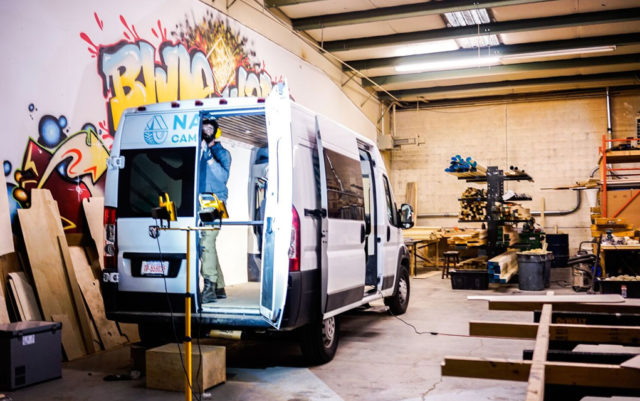
By the time Dave Walsh built out his third van, he had reached a turning point. What had begun as a single backyard project to transform a van into a year-round livable unit was becoming Walsh’s business.
That business: converting Sprinter vans (and similar models, like Dodge Promasters and Ford Transits) into custom-built, solar-powered homes on wheels. Without meaning to, he now finds himself with a queue of clients, a workspace in Denver and two employees. It’s not quite where he’d expected to be.
“If you would have asked me a year ago, ‘You think you’re going to be building vans for people in a year?’ I would have said, ‘No! I’m gonna be in my van traveling,’” Walsh says.
That’s part of his edge in this niche industry. Not only does he come from a family of carpenters and mechanics, but he designed, built out and lived in his own solar-powered Sprinter for a year before coming back to a more settled lifestyle with an apartment in Boulder.
“Van life,” as Walsh calls it, is about living small, staying mobile and using less energy — like the “tiny house on wheels” movement, only tinier, and with more emphasis on the wheels. His van, named “Betty White,” replaced the energy footprint of his house and his vehicle with 150 watts of solar panels on the roof, which powered the interior LED lights and small electronics, and an engine. It was a way to live closer to nature, basing himself in one remote destination after another, parking on Forest Service roads or public lands close to mountain biking trails and other outdoor play. Van life was also, somewhat ironically, a way to stay connected to community, “because you can only spend so much time in your tiny little van.”
Now, he spends his days helping others experience van living. Of course, Walsh had a life before van life. The native Rhode Islander spent four years in the Marines before landing in San Diego, where he spent eight years, had a career and was married.
“I was chasing the American dream,” he says. “We moved to Colorado, had two dogs, a brand new car — it was like, great, this is awesome.”
But following his divorce, Walsh dramatically changed directions. After losing his job in Boulder’s IT sector, he started a handyman business, scaled back his high-cost lifestyle and focused on intentionally living with less. He soon found himself building Betty White, and embarking on the journey that led him here.
The vans he builds now look a lot like Betty White, combining custom woodworking and design with appliances designed for sailboats and RVs. There’s a steel-framed, raised platform bed in the back, mounted to the wall. The walls and ceiling are fully insulated and covered in custom wallboards and paneling. All the vans are wired for solar with battery storage, although one of his customers has opted not to put panels on the roof. That’ll change moving forward, Walsh says. In the future, all vans will include rooftop solar, and thus be equipped to power the lights and small plug loads when the van is off, using solar energy to keep the batteries charged rather than having to run the engine to do so (or to bring along a generator, as some “van lifers” do).
There’s a sink with a collapsible faucet and removable top, and a small pump to draw water from one jug underneath and drain it into another, both small enough to fill and empty by hand. There’s a fridge that doubles as a seat, alongside a fixed bench. All drawers lock in place — the van will often be in motion, after all. He doesn’t install desks in the vans; it’s best to work in a coffee shop and interact with people, he says.
Walsh spent much of January building out just such a van for another local company, Native Campervans in Denver, who’ll rent it out to adventurers wanting to try the lifestyle for a weekend or so.
Every van is unique and Walsh is committed to customizing each buildout, even as he balances the need to streamline his workflow as the business grows, while trying to keep costs low.
“People moving into a van aren’t moving into a van because they’re rich,” he says. “They’re doing it because it makes sense.”
They’re trading in rent, or a mortgage, and a utility bill for gasoline at the pump. They’re removing one of their biggest carbon footprints — a building to live in — from their lives, at least temporarily, and making their means of mobility their shelter.
For now, Walsh will have to live van life vicariously, staying put as his business takes off. But it’s worth it, so that more people experience the benefits of the lifestyle, not just in their pockets but in their community.














